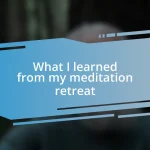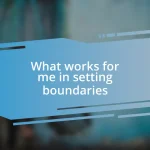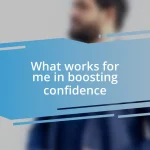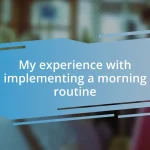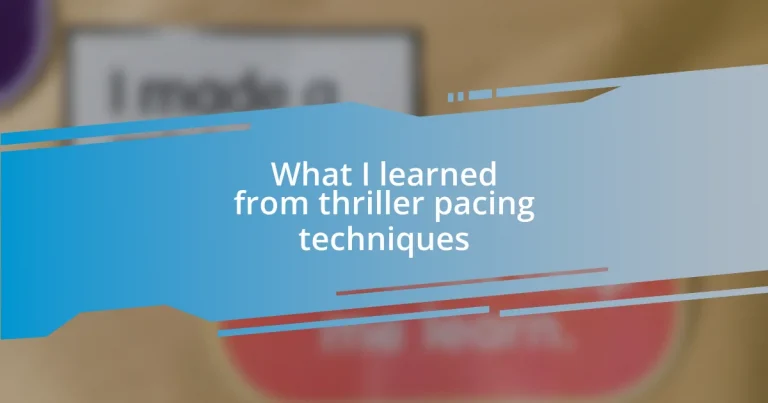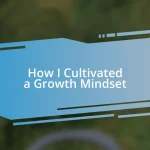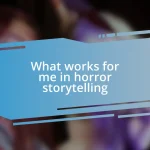Key takeaways:
- Pacing in thrillers is essential for building tension and maintaining reader engagement, utilizing techniques like short sentences during action and cliffhangers at chapter ends.
- Effective pacing involves balancing action with character development, allowing space for reflection to deepen emotional investment.
- Practical applications in writing include manipulating sentence length, foreshadowing hints, and using sensory details to create immersive experiences for readers.
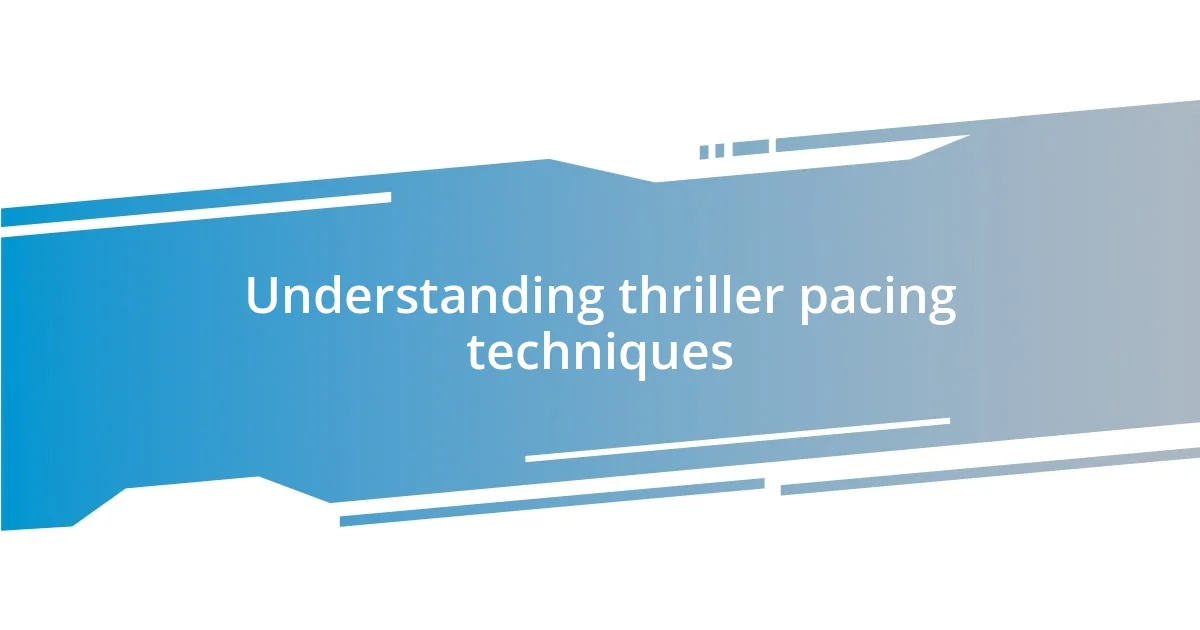
Understanding thriller pacing techniques
Pacing in thrillers is like the heartbeat of your story; it needs to quicken during tense moments and slow down during emotional scenes. I remember reading a novel that had me racing through the pages, and I realized how critical it is to build suspense through a careful interplay of fast and slow moments. It got me thinking—how do authors create that effective rhythm?
One technique that stands out to me is the use of short, punchy sentences during action sequences. They serve to propel the reader forward, almost mirroring the character’s urgency. When I was writing my own thriller, I experimented with this; the result was electrifying, as if I could feel my own heart racing alongside the plot. If you’ve ever felt that rush while reading, you know how captivating this technique can be.
Additionally, embedding cliffhangers at the end of chapters is another potent tool. They keep readers on the edge of their seats, eager to know what happens next. During one late-night writing session, I placed a cliffhanger just as a character was about to face a life-or-death decision, and it thrilled me to see how it shaped the narrative flow. Have you ever abandoned a book because the pacing felt sluggish? That’s the beauty of mastering pacing in thrillers; it transforms the reading experience into something unforgettable.
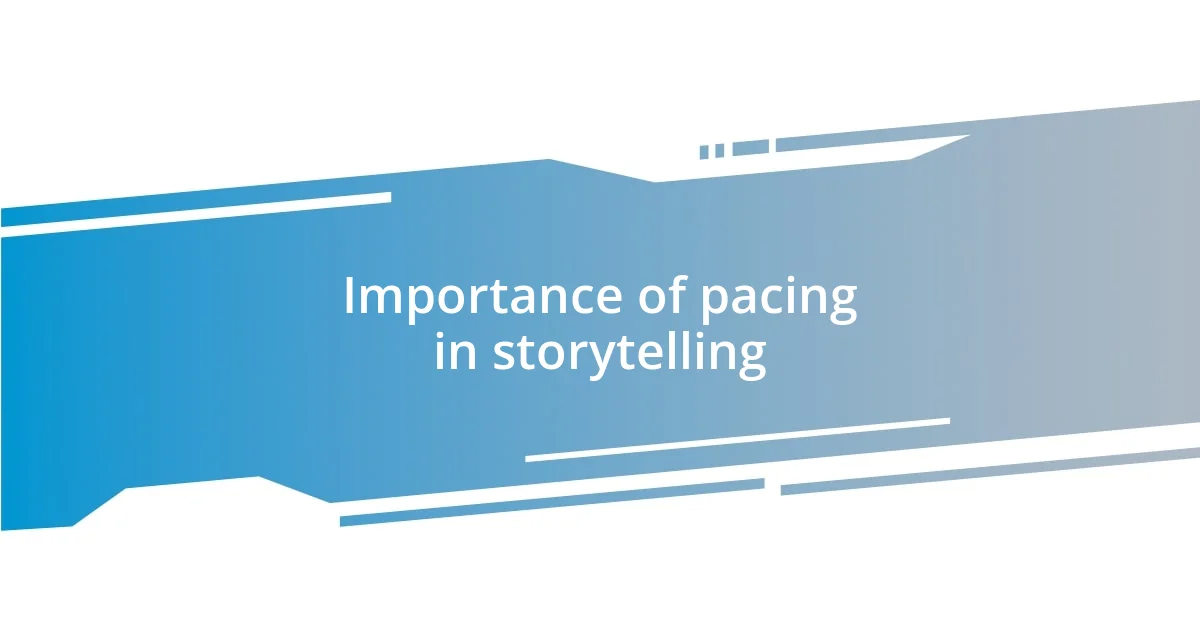
Importance of pacing in storytelling
Good pacing is crucial in storytelling because it directly impacts how readers engage with the narrative. I can’t count the times I’ve been completely engrossed in a story only to lose interest because the rhythm felt off. I once picked up a book that lingered on exposition for too long; by the time action started, I’d mentally checked out. This taught me that pacing isn’t just a technical skill—it’s the heart of a story that keeps readers invested.
To effectively leverage pacing in your storytelling, consider these key elements:
– Tension and Release: Alternating between high-stakes moments and quieter scenes helps maintain a gripping narrative.
– Character Development: Slower pacing can provide depth to characters, allowing readers to connect on an emotional level.
– Scene Transition: Smooth transitions between fast and slow moments guide readers through the emotional highs and lows seamlessly.
– Reader Expectations: Understanding what readers anticipate can help you skillfully lead them, keeping them both surprised and satisfied.
Reflecting on my own writing, it’s clear that intentional pacing creates an immersive experience, making the storytelling more vibrant and engaging.
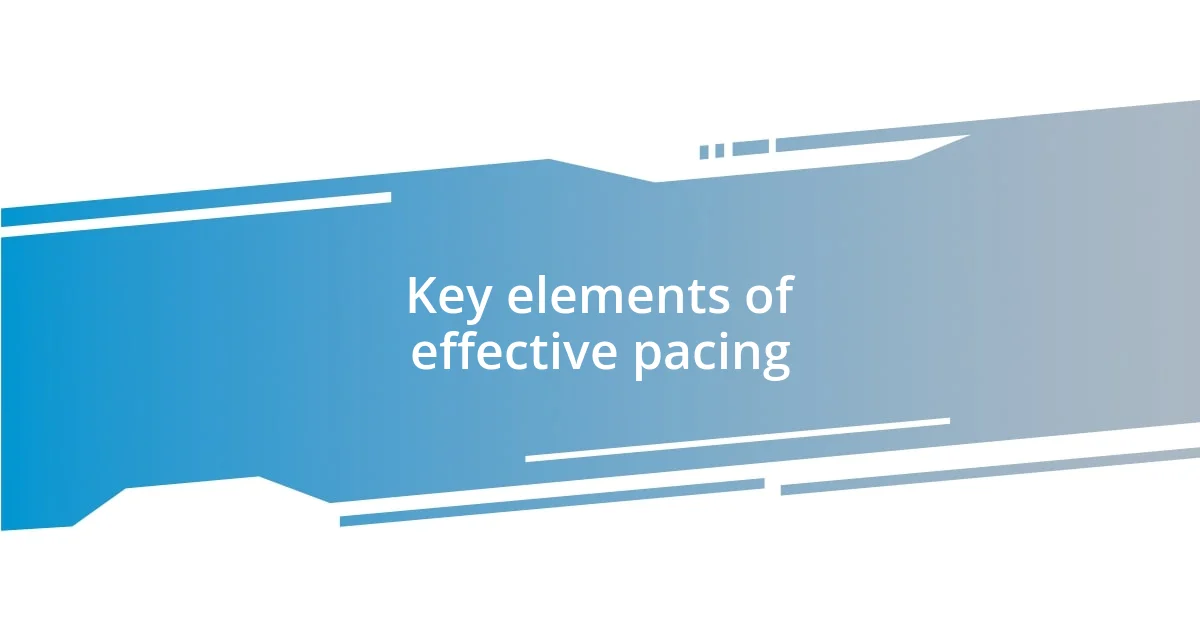
Key elements of effective pacing
Pacing isn’t just about the speed of a story; it’s about strategically orchestrating moments that evoke emotion and tension. One element I’ve consistently found effective is the artful use of dialogue. For instance, when characters engage in rapid-fire exchanges during heightened scenarios, it adds urgency. I once drafted a scene where two characters were caught in a chase, and their quick dialogue mirrored their racing hearts. It’s fascinating how words can amplify the sense of speed and danger, drawing readers deeper into the action.
Another critical aspect of effective pacing is the deliberate withholding of information. I recall crafting a scene where the protagonist discovers a shocking secret but is interrupted before revealing it. This not only built suspense but also kept readers guessing, creating an addictive rhythm. The anticipation of what would be unveiled next pulled me into the narrative, showcasing how a few well-timed revelations can enhance pacing dramatically. It’s a balance of revealing just enough while keeping the audience yearning for more.
Lastly, transitions between scenes play a pivotal role in pacing. When switching from a rapid sequence to a slower reflection, I emphasize a pause—a moment of silence, if you will. In my own writing, I can still feel the weight of a reflective moment that follows an intense climax. It gave me space to breathe, allowing readers to process emotions before plunging back into the action. This ebb and flow create a natural rhythm that enhances the reader’s overall experience.
| Key Element | Description |
|---|---|
| Tension and Release | Alternating between high-stakes moments and quieter scenes to maintain grip. |
| Dialogue Dynamics | Rapid exchanges can mirror urgency during action sequences. |
| Information Withholding | Deliberately revealing less keeps readers guessing and engaged. |
| Scene Transitions | Using pauses to reflect helps balance intense moments with emotional depth. |
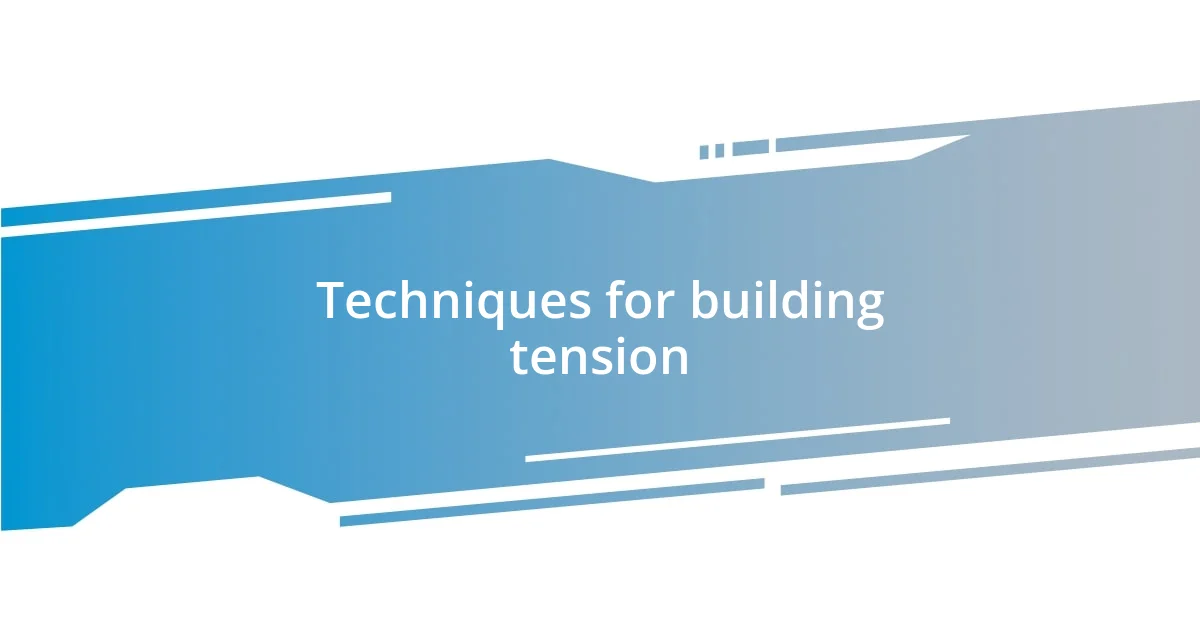
Techniques for building tension
Building tension in a story often comes down to how you strategically manipulate the flow of information. I recall a scene I wrote where the protagonist is on the verge of uncovering a dark secret about their family. Instead of spilling everything at once, I provided just a tantalizing hint, letting the readers wonder and ponder what could be lurking in the shadows. Doesn’t that feeling of anticipation make the reveal even more satisfying? It’s like the thrill of waiting for the next twist in a roller coaster ride; the longer you hold it, the more exhilarating the payoff.
Another technique I’ve embraced is the use of sensory details to heighten tension. In one piece, I described a character feeling the chill in the air as they approached a deserted house. The creaking floorboards, the musty smell—it all pulled me into that moment. I’ve found that painting vivid imagery doesn’t just enhance the atmosphere; it invites readers to feel the same anxiety as the characters. Have you ever noticed how your heart races in sync with a character’s fear? That’s the magic of immersive detail.
Lastly, pacing can be manipulated through sentence structure. Short, abrupt sentences can create a sense of urgency, while longer, flowing sentences allow for reflection. I experimented with this in a chase scene by interspersing rapid sentences depicting action with longer descriptions of the character’s thoughts as they processed what was happening. It wasn’t just driving the plot forward; it was forcing readers to feel that frantic energy while also giving them space to breathe. Isn’t that balance key in keeping a reader turning pages, desperate for more?
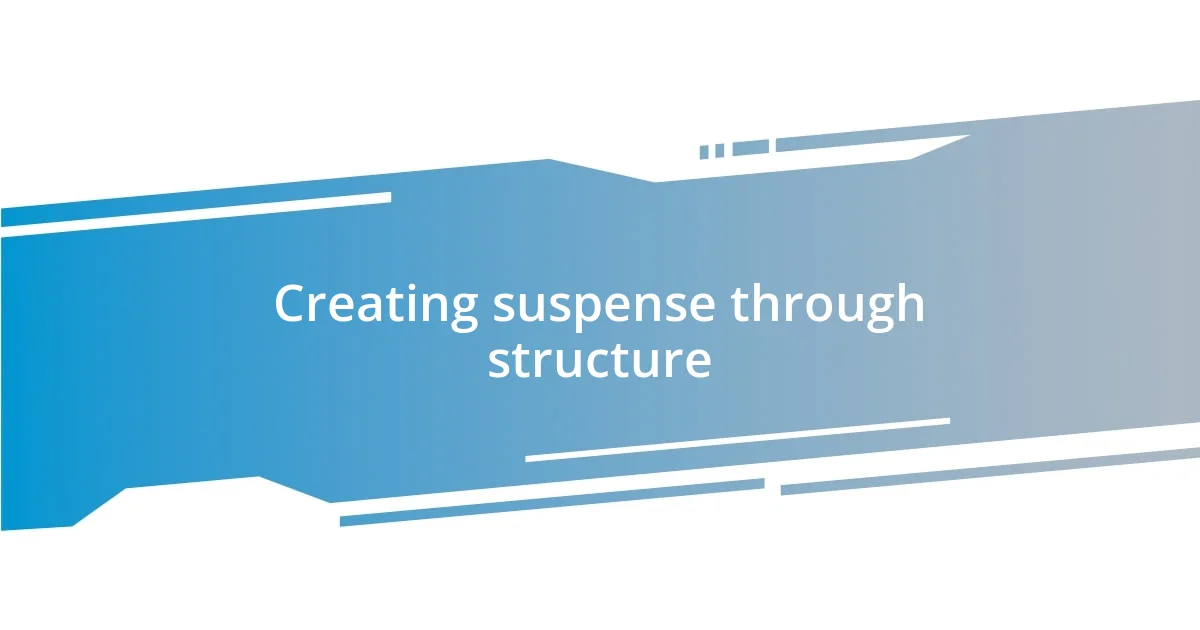
Creating suspense through structure
To create real suspense through structure, I’ve found that the placement of pivotal scenes can be incredibly powerful. I once experimented with revealing a crucial plot twist midway, rather than at the climax. The effect was electrifying; it transformed reader expectations and threw them into a whirlwind of unpredictability. I felt how my own heart raced as I anticipated the audience’s reaction, as they grappled with the implications of that revelation. Don’t you think changing the traditional structure keeps readers on their toes?
Another element I’ve explored is the use of cliffhangers at the end of chapters. I vividly remember a time I ended a chapter just as a character stepped into a dark room, leaving readers hungry for answers. The suspense created by such a structure not only encourages page-turning but also enhances emotional investment. I still feel the thrill of weaving that tension into my writing—it’s like giving readers a delicious tease that leaves them craving more. Have you ever turned the page, desperate to know what happens next?
Additionally, I emphasize the importance of pacing when it comes to subplots. I often intersperse lighter, seemingly unrelated storylines that build tension toward the main plot. I tried this once, juxtaposing a character’s mundane daily life against escalating danger in another’s life, and it created a fascinating contrast that heightens suspense. It’s intriguing how shifting perspectives can enrich the reader’s engagement—don’t you agree that keeping readers guessing about when these threads will collide is a recipe for suspense? By carefully orchestrating these elements, I’ve discovered the art of keeping readers on the edge of their seats.
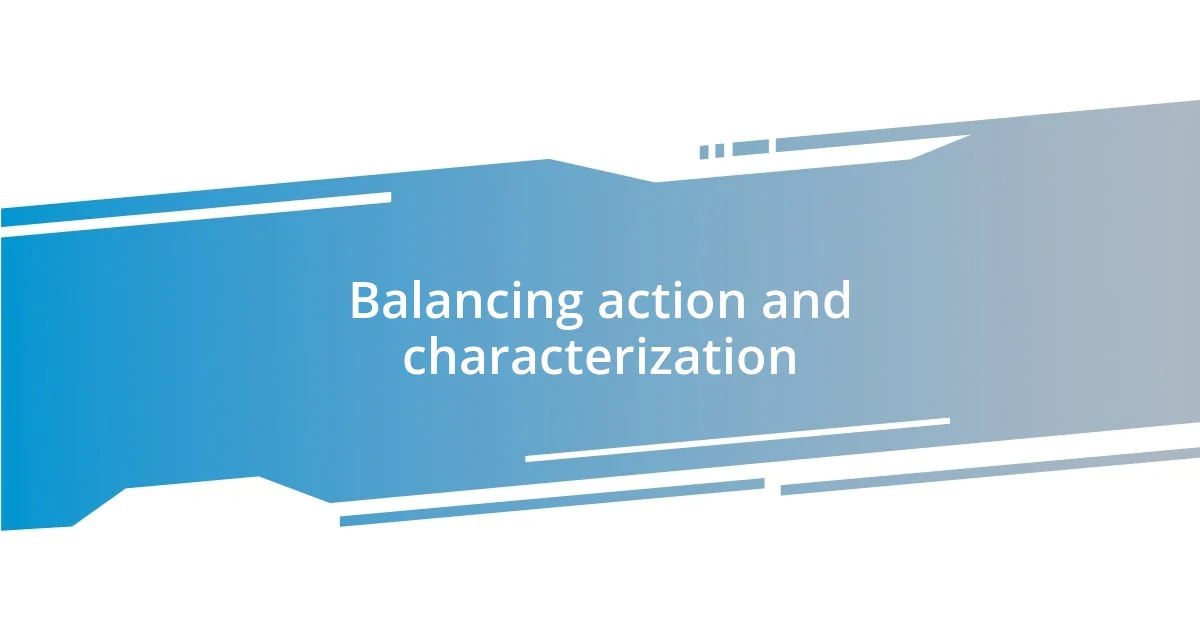
Balancing action and characterization
Balancing action and characterization is a delicate act that I’ve grown to appreciate deeply. I remember crafting a scene where a high-stakes chase intertwined with a character’s internal conflict about their past. The action was relentless, but I made sure to weave in moments where the character reflected on their motivations. This not only heightened the urgency but also added layers to their personality. Have you ever felt the thrill of not just the chase, but the emotional stakes behind it? That combination keeps readers invested on multiple levels.
In my experience, characters become more relatable when their actions resonate with their struggles. I once wrote a scene where a character had to choose between saving a friend or pursuing a villain. The frantic pace of the action was gripping, but it was their inner turmoil that truly captured the reader’s heart. Balancing those moments of adrenaline with introspection allows readers to connect on a personal level. Isn’t it fascinating how a brief pause for reflection can elevate an action scene into something profound?
It’s essential to remember that while action moves the plot, characterization gives it substance. I’ve found that slowing down during key moments of action can amplify tension. For instance, I once described a character taking a breath before making a critical decision during a fight. This pause allowed readers to experience the weight of the moment, heightening their emotional investment. Just as in life, sometimes the most impactful moments come when we allow ourselves to feel, rather than rush forward blindly. How about you—do you think adding those reflective pauses makes a difference in storytelling? It surely has for me.
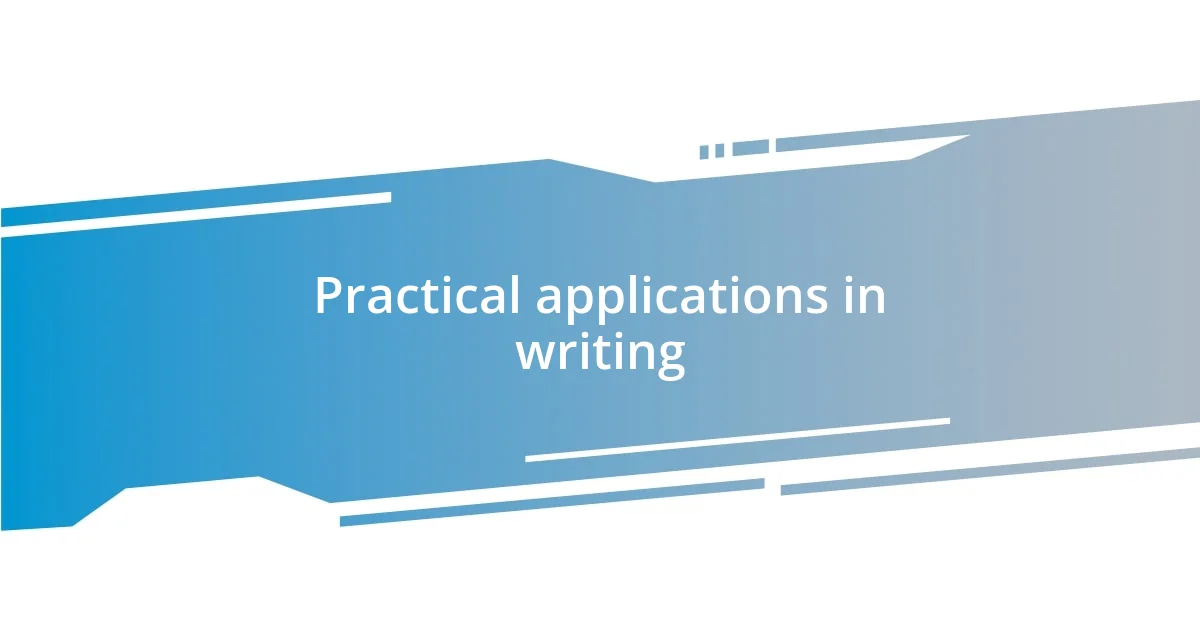
Practical applications in writing
When it comes to practical applications in writing thriller pacing techniques, one strategy that consistently works for me is manipulating sentence length to control tension. I recall a time when I decided to alternate between long, flowing sentences in quieter moments and short, abrupt ones during intense scenes. This technique not only mirrored the rising stakes but created a visceral rhythmic experience for the reader. Have you ever noticed how a simple change in sentence structure can evoke such a profound emotional response?
Another approach I’ve found effective involves using foreshadowing to build anticipation. I remember incorporating subtle hints about a character’s ulterior motives, sprinkled throughout the narrative. This layered storytelling not only kept readers guessing but made the eventual reveal much more satisfying. It’s astonishing how a little hint can transform a moment into a thrilling ‘aha’ experience. Isn’t it exciting to craft that kind of payoff for your audience?
Additionally, I engage readers through immersive sensory details, particularly in climactic scenes. I once described the sound of footsteps echoing in an empty alley, painting a picture so vivid that it drew readers right into the heart of the tension. Engaging multiple senses allows readers to feel the urgency and anxiety alongside the characters. How do you see sensory details enhancing your own writing? I believe they can be a powerful tool that deepens the reader’s connection to the story.
